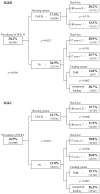Epidemiological Features of Postpartum Subclinical Ketosis in Dairy Herds in Hokkaido, Japan
- PMID: 38200875
- PMCID: PMC10778376
- DOI: 10.3390/ani14010144
Epidemiological Features of Postpartum Subclinical Ketosis in Dairy Herds in Hokkaido, Japan
Abstract
This study was carried out as an observational study in order to determine the prevalence of postpartum subclinical ketosis (SCK) in dairy herds in Hokkaido, Japan. From April 2012 to March 2014, blood β-hydroxybutyrate (BHBA) concentration was measured once within 3-88 days in milk (DIM) in 1394 apparently healthy cows from 108 farms to diagnose SCK (≥1.2 mM). In cows within 14 DIM, this was classified as SCK II, and from 15 DIM, this was classified as SCK I. Herds with a combined percentage of SCK I and SCK II of less than 10% were classified as SCK-negative herds, those with percentages of 10-25%, were classified as alert herds, and those with one of 25% or more, we classified as positive herds. The prevalence of SCK in the entire DIM was 17.6%. The prevalence of SCK II (20.2%) tended to occur more frequently than SCK I (16.5%, p = 0.094). The frequency of SCK I was higher at the fourth parity. The number of milking cows in SCK-positive herds was significantly smaller than those of the other two types of herds (p = 0.004). The frequency of SCK-positive herds in tie stalls and with component feeding was higher than for free stall or free barn and with total mixed ration (p = 0.054 and p = 0.002). This study reveals the prevalence of SCK in Hokkaido, Japan, and shows that SCK is associated with parity and the management system.
Keywords: dairy cow; postpartum; prevalence; risk factor; subclinical ketosis.
Conflict of interest statement
The authors declare no conflicts of interest.
Figures


Similar articles
-
Prevalence of subclinical ketosis and relationships with postpartum diseases in European dairy cows.J Dairy Sci. 2013 May;96(5):2925-38. doi: 10.3168/jds.2012-6035. Epub 2013 Mar 15. J Dairy Sci. 2013. PMID: 23497997
-
Epidemiology of subclinical ketosis in early lactation dairy cattle.J Dairy Sci. 2012 Sep;95(9):5056-5066. doi: 10.3168/jds.2012-5443. J Dairy Sci. 2012. PMID: 22916909
-
Subclinical ketosis in post-partum dairy cows fed a predominantly pasture-based diet: defining cut-points for diagnosis using concentrations of beta-hydroxybutyrate in blood and determining prevalence.N Z Vet J. 2015 Sep;63(5):241-8. doi: 10.1080/00480169.2014.999841. Epub 2015 Jun 15. N Z Vet J. 2015. PMID: 25578216
-
Global prevalence of subclinical ketosis in dairy cows: A systematic review and meta-analysis.Res Vet Sci. 2022 May;144:66-76. doi: 10.1016/j.rvsc.2022.01.003. Epub 2022 Jan 17. Res Vet Sci. 2022. PMID: 35077992
-
Diseases, reproductive performance, and changes in milk production associated with subclinical ketosis in dairy cows: a meta-analysis and review.J Dairy Sci. 2014 Dec;97(12):7547-63. doi: 10.3168/jds.2014-8237. Epub 2014 Oct 11. J Dairy Sci. 2014. PMID: 25306269 Review.
Cited by
-
Factors Affecting Milk Productivity, Milk Quality and Dairy Cow Health.Animals (Basel). 2024 Dec 23;14(24):3707. doi: 10.3390/ani14243707. Animals (Basel). 2024. PMID: 39765611 Free PMC article.
-
Update on ketosis in dairy cattle with major emphasis on subclinical ketosis and abdominal adiposity.Vet Med Sci. 2024 Sep;10(5):e1525. doi: 10.1002/vms3.1525. Vet Med Sci. 2024. PMID: 39212249 Free PMC article. Review.
References
Grants and funding
LinkOut - more resources
Full Text Sources
Miscellaneous

